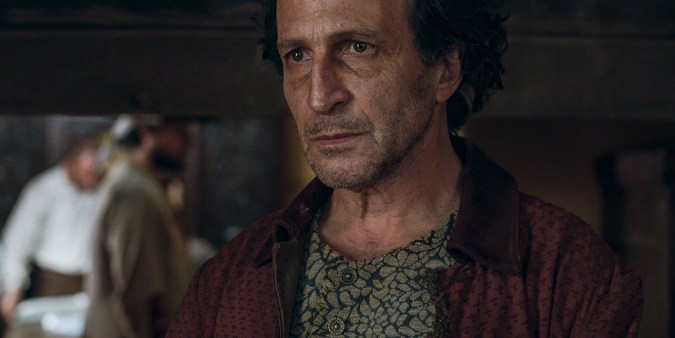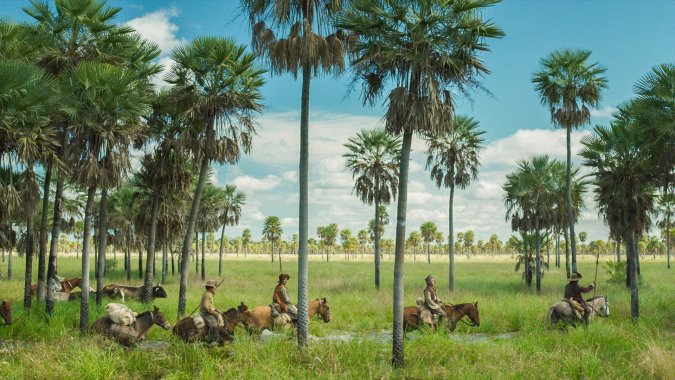Lucrecia Martel’s Zama is that rare period piece that feels of and about its time. Based on the novel by Antonio Di Benedetto, it’s a look at Latin America’s colonial history, the ambitious film follows Don Diego de Zama (Daniel Giménez Cacho) as he hopes to be relocated out of Asunción and back with his family. His mind and body are slowly giving up; he cannot stand any more time in what feels like the end of the world where Spanish rule (and even Buenos Aires) feel like remote sites of power. In the dust-covered landscape, where his fussy garments feel all too inadequate (we see slaves wearing jackets and little else while indigenous people’s attire feels much more weather-appropriate), he has a hard time feeling optimistic about his prospects. Women do little else than tease him, officials shun him and ignore his authority. As he gets more and more frenzied, audiences are taken on a feverish journey to capture an elusive bandit that’s been terrorizing the nearby trading routes. It is alas, the kind of journey that’ll prove futile, an excuse for Martel to show off the awe-inspiring unspoiled geography of pre-colonial Latin America and indict the colonial project in the process.
After bowing at the Venice Film Festival and screening at the Toronto International Film Festival, Martel’s film arrives in the U.S. at the New York Film Festival where it’s already been greeted as a masterpiece. It’s no doubt why the epic was chosen by Argentina as its submission to this year’s Academy Awards’ Foreign Language category. Following a showing of the film at this year’s NYFF, the lauded Argentinean filmmaker sat down for a lively Q&A with the press. Martel had nothing but glowing things to say about her leading man who gives a shattering performance as a man broken by the colonial nightmare he’s helped construct. As the title character the Bad Education actor plays witness both to the crippling effects Europeans had on the southern Americas as well as victim to the bloodthirsty need of those in power to ravage the land and people therein. Check out more highlights from the Q&A below.
Zama screens as part of the New York Film Festival.
On Treating the Past as Science Fiction
Indeed, I was working, since roughly 2009 on a science fiction film. An adaptation of El eternauta, which is a very iconic comic book in Argentina. Ultimately that didn’t come to happen. And as a way of escaping from that situation—I had been working on that project for a while—I took a trip. On that trip I read Zama. Coincidentally, that comic book and Zama were both written and published around the same time, at the end of the 1950s. The voyage we see at the end of the film is not that different than the ending I’d written for the ending of El eternauta, where the survivors escape in a boat. And that’s what I did myself. So, for me, the origin of Zama is really rooted in that experience, which I fled—on a boat no less! When thinking about adapting this comic book that takes place in the future, I kept going back to this idea of how do we represent the future? Even a kind of an odd vision of the future, because it’s obviously rooted in the 1950s—their version of the future. All those questions I was having about that made me think about how we think and represent the past. Normally, we think of approaching the past with less freedom than we do the future ahead. So you think about science fiction with an unending sense of possibility but when thinking about a historical film, there’s always a sense of needing to hew very closely to the facts. When I decided to make Zama, I decided to adapt it with the same kind freedom with which I was approaching El eternauta. And, for political reasons too.

On Excluding the Catholic Church From Her Film
The story of our continent has been written by the white Man, for those who won the conquest. So to falsify that story didn’t strike as that irreverent or such a big deal. In fact, I took certain liberties that go against Latin American history because I nixed every reference to the Catholic Church from the film. Which was hard. Because when we were looking at furniture or props from that era, for example, immediately we’d come across things that had crosses or other symbols of the Church. And I very deliberately wanted them out of the film, so we could think about a civic past, a continent engaged in a civic conflict, not a religious one. We had to take back a lot of furniture! Because our country’s past is so enmeshed with the Church that it obscures other types of conflicts that have occurred in our land. And it also blocks these more existential conflicts. This is not something that comes out of nowhere. It comes out of the novel on which this film is based. Because that book really goes against this idea of hope, which is a very Catholic concept in our culture. It’s this concept that the life’s meaning will come at the end. That you have to suffer whatever comes your way because in the end there will be a revelation that will give meaning to your suffering, or your poverty. I’m not going to say that Zama is the anti-Christ, but there’s no doubt that he does push against that model.
On Her Focus On the Body
The reason why people turn to the arts, to writing, to theater—and why I turn to film—why people choose to create is because, and this is my theory, is because we are all very much alone within our bodies. Our body is an island inhabited solely by us. We’ve invented many things to relate to other islands: language, love, cinema, theater. The body is a very complex geography from which I build my films and one on which I reflect a lot about, inevitably. So we make all these things to overcome this solitude. It’s very difficult, if you think about this way, to tell any kind of human drama without it having the body as its main concern.
On Pushing Back Against Oppression On-Screen
Especially when we’re thinking about colonization, we need to think of its violence and the many ways it delegitimizes the Other’s body. That’s its first step. It’s very difficult, even for a very bad person, to exercise violence. This is why we’ve designed gas, tanks, planes—to really narrow and fog up one’s vision. It’s not easy to kill someone. The first thing one needs to do to destroy another is not see them. All that Western propaganda, for example, where we try to see the Muslim world in terms of “Oh, they stone women and kill gays”—to really paint that with such broad strokes a large population, that’s because we need to deny their humanity to warrant our violence. And one needs to make sure that the depictions of the bodies of indigenous people or slaves don’t fall into that same simplifying mode, especially in a film where the protagonist is a white man. What we did, all of us involved in the film, was make sure that all these bodies we saw—be they of slaves or indigenous people or women—would carry themselves with no sense of submission, with no gestures that would suggest that. Utter oppression can only be represented when it is depicted by the oppressor. That’s what you see in 1950s film where you’d see these black characters in comedies as servants with just a sense of posture and gesture that denoted their own submission. And so, you can only ever see a perfect, unilateral sense of oppression when it’s depicted by the oppressor. In reality, oppression is never perfect, never total. In our history, the situation of indigenous people, of slaves, of women, it wasn’t one of perfect submission. It was important for us to portray that.
On the Film’s Soundtrack
I chose this music which is performed by a Brazilian duo called Los Indios Tabajaras. They were allegedly of Tabajara origin. The specificity of these songs is that they covered very popular Latin American songs (in the 1950s) with this desire to make it in Hollywood. And this connects back to this idea that I was talking about earlier, of the temporality of the film. This movie is based on a novel that takes place in the eighteenth century, but it was written in the 1950s, and it was developed in the 21st century. So what’s this film’s temporality? When does it take place? It’s a very specific thing we do when we think about these different temporalities. In that sense, the plotted time here resembles the real time—that is, it just needs to resonate in the present, not that it evokes a perfect kind of past. The time era represented has to speak to our own time. And the music of the Tabajaras has that pretentious quality of Latin America—of Argentina, in particular, where it doesn’t think of itself as Latin America but thinks of itself in this weird place somewhere between Miami and Europe. So that’s why I thought it made sense for this film.
This Q&A was conducted in English and Spanish (with an interpreter present). Martel’s answers in Spanish have been translated to English by the author for Remezcla.






